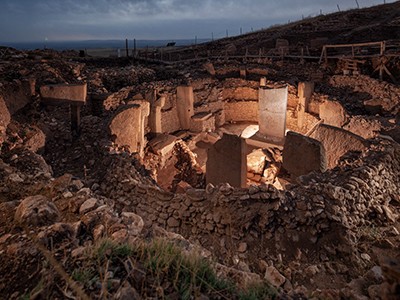- NEWS
Ancient smells reveal secrets of Egyptian tomb
More than 3,400 years after two ancient Egyptians were laid to rest, the jars of food left to nourish their eternal souls still smell sweet. A team of analytical chemists and archaeologists has analysed these scents to help identify the jars' contents1. The study shows how the archaeology of smell can enrich our understanding of the past — and perhaps make museum visits more immersive.
The 1906 discovery of the intact tomb of Kha and Merit in the Deir el-Medina necropolis near Luxor was a landmark moment in Egyptology. The tomb of Kha — a 'chief of works', or an architect — and Merit, his wife, remains the most complete non-royal ancient burial ever found in Egypt, revealing important information about how high-ranking individuals were treated after death.
"It's an amazing collection," says Ilaria Degano, an analytical chemist at the University of Pisa, Italy. "Among the objects, there are even examples of Kha's ancient Egyptian linen underwear, embroidered with his name."
Unusually for the time, the archaeologist who discovered the tomb resisted the temptation to unwrap the mummies or peer inside the sealed amphorae, jars and jugs there, even after they were transferred to the Egyptian Museum in Turin, Italy. The contents of many of these vessels are still a mystery, although there are some clues, says Degano. "From talking with the curators, we knew there were some fruity aromas in the display cases," she says.
Odour analysis
Degano and her colleagues placed various artefacts — including sealed jars and open cups laden with the rotten remains of ancient food — inside plastic bags for several days to collect some of the volatile molecules they still release. Then the team used a mass spectrometer to identify the components of the aromas from each sample. They found aldehydes and long-chain hydrocarbons, indicative of beeswax; trimethylamine, associated with dried fish; and other aldehydes common in fruits. "Two-thirds of the objects gave some results," Degano says. "It was a very nice surprise."
The findings will feed into a larger project to re-analyse the tomb's contents and produce a more comprehensive picture of burial customs for non-royals that existed when Kha and Merit died, about 70 years before Tutankhamun came to the throne.
This isn't the first time that scent compounds have revealed important information about ancient Egypt. In 2014, researchers extracted volatile molecules from linen bandages that are between 6,300 and 5,000 years old that were used to wrap bodies in some of the earliest known Egyptian cemeteries2. The molecules confirmed the presence of embalming agents with antibacterial properties, showing that Egyptians were experimenting with mummification some 1,500 years earlier than had been thought.
Odour analysis is still an underexplored area of archaeology, says Stephen Buckley, an archaeologist and analytical chemist at the University of York, UK, who was involved in the 2014 study. "Volatiles have been ignored by archaeologists because of an assumption they would have disappeared from artefacts," he says. But "if you want to understand the ancient Egyptians, you really want to go into that world of smell".
For example, sweet-smelling incense derived from aromatic resins was essential for the ancient Egyptians. "Incense was necessary for temple ceremonies and for some mortuary rituals," says Kathryn Bard, an archaeologist at Boston University in Massachusetts. Because resin-producing trees didn't grow in Egypt, this necessitated ambitious long-distance expeditions to obtain supplies.
Enriched exhibits
Aside from revealing more about past civilizations, ancient smells could add a dimension to the visitor experience at museums. "Smell is a relatively unexplored gateway to the collective past," says Cecilia Bembibre at University College London. "It has the potential [to allow] us to experience the past in a more emotional, personal way."
But reconstructing ancient smells is not easy, says Bembibre. Degradation and decomposition can be a smelly business, so the scents from an artefact today do not necessarily match what Bembibre calls the original "smellscape" of a tomb.
With the right knowledge and understanding, it should be possible to pull the original and the decomposition scents apart, says Buckley. Whether visitors would actually want to experience the full and potentially unpleasant smellscape of an ancient tomb is still up for debate. "Curators might want to give people a choice over how far they want to push the smell experience," says Buckley.
doi: https://doi.org/10.1038/d41586-022-00903-z
References
-
La Nasa, J. et al. J. Archaeol. Sci. 141, 105577 (2022).
-
Jones, J. et al. PLoS ONE 9, e103608 (2014).
-- Sent from my Linux system.



No comments:
Post a Comment